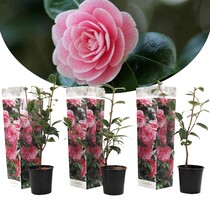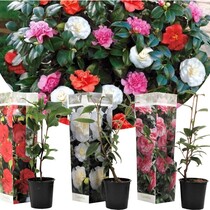Camellia is an evergreen plant and blooms profusely in spring!
Camellia plants should not be missing in your garden, this winter hardy and leafy plant comes in different colours. Order them easily online at Garden Select.
Read moreCamellia Japonica should not be missing in any garden, this beautiful ornamental shrub that retains its leaves in winter can be ordered in various colours.
Read moreCamellia plants are indispensable in the garden. Camellia Japonica come in various colours and retain their foliage all year round.
Read moreCamellia Japonica is a highly sought-after garden and pot plant. These plants are hardy and retain their leaves, even giving flowers twice in the year.
Read moreCamelia 'Camellia'
Camellia species are evergreen shrubs that produce white, red or pink flowers every year. The flowers have yellow stamens that attract bees and butterflies. These flowering ornamental shrubs are also called Japanese Roses. They are acid-loving shrubs that combine well with shrubs like the rhododendron and Japanese maple varieties. Most camellia varieties flower from February until April. They are therefore often early-flowering shrubs. There are also late-flowering Camellia shrubs, which are called Camellia Sananqua. Combining the Camellia with summer-flowering shrubs ensures long-lasting flowering in your garden or garden border. The ornamental value of the Camellia is the flowering, but the leaves are also pretty to look at (fresh glossy green).
Camelia location and combinations
All Camellias like a spot in semi-shade or a border with light shade. Plant them in a spot on the west side of a house/shed or against hedge plants. Camellia shrubs are acid-loving garden plants, which means they require acidic soil. So annual fertilisation with garden turf to keep the soil acidic is appreciated. You can also choose to combine them with deciduous shrubs. It's best to leave the fallen leaves, which maintains an acid soil or garden soil.
Flowering months Camellia 'Camellia
All Camellia species flower in spring. The first flowers appear around February and continue flowering until the end of April. The flowering colours of the camellia are diverse and vary from purple and red to white and pink. With these, they add a nice colour accent to any garden.
Popular varieties of Camellia 'Camellia
The most popular varieties of Camellia 'Camellia' are the japonica, whose variants are Japonica 'bonomania' Pink and Japonica 'Black lace' Red. 'Camellia' Williamsii ' volunteer' pink, and the cross of this japonica x williamsi.
Pruning and care of Camellia 'Camellia'
Prune after flowering, around May to keep the shrub in shape. Remove protruding branches to maintain its shape. For example, protruding branches or branches hanging over the path. Use clean tools for this.
Fertilising camellia, when and how
When planting, dig acid-loving planting soil through your existing soil. Give the plant garden turf or acid-loving fertiliser every year in spring to keep the soil acidic. An acidic soil is necessary for the plants to absorb nutrients. You can also work with French tree bark. This will prevent the soil from drying out.
Avoid standing too dry in hot summers and definitely too wet in autumn and winter. Make sure the soil is well-drained, drainage and so on.





